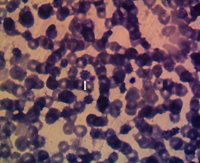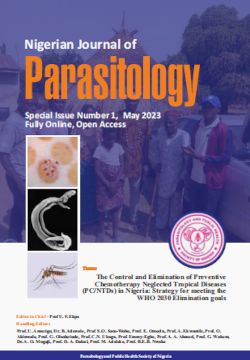Prevalence, Risk Factors, Haematological and Biochemical Changes Associated with Haemotropic <i>Mycoplasma</i> Infection of Dogs in Abeokuta, Ogun State, Nigeria
DOI:
https://doi.org/10.4314/njpar.v45i2.8Keywords:
Prevalence, Haematology, Biochemistry, Mycoplasma infection, DogsAbstract
This study was carried out to determine the prevalence, risk factors, haematological and biochemical changes associated with haemotropic Mycoplasma infection in dogs presented to the Veterinary Teaching Hospital, Federal University of Agriculture, Abeokuta (FUNAAB). A total of 70 dogs were examined; their ages, breeds and sexes were recorded. Blood samples were collected for haematological and biochemical analysis. Data was summarized as mean ± standard deviation. Association between risk factors and infection was determined using Chi Square while difference between mean values in infected and non-infected dogs was tested using student’s t-test. The overall prevalence of 14 (20%) was recorded. The prevalence was slightly higher 9 (20.9%) in adult dogs, as well as in females 8 (22.2%%) and the breed Samoyed 2 (40.0%). The mean PCV in infected dogs was 33.4±7.60 while that of non-infected dogs was 35.1±9.21. There was no significant difference in the haematological values between infected and non-infected dogs. There were also no significant values in most of the biochemical parameters between infected and non-infected dogs, except for potassium which was 2.85±0.96 in infected and 3.97±0.58 in noninfected dogs; chlorine (81.93±16.82) and (98.95±11.82); glucose (87.91±25.82) and (115.33±32.21) as well as urea (21.45±10.84) and (14.83±4.01) in infected and non-infected dogs, respectively. However, in both cases, the leukocytes, neutrophils and lymphocytes count as well as urea concentration were higher than normal values. While only potassium and chlorine concentration were lower than normal in the infected dogs, when compared to those in the reference values. In conclusion, the prevalence of Mycoplasma infection was high in the study area. Dogs are at risk of infection by Mycoplasma organisms. Mycoplasma infection did not cause haematological and biochemical changes, but haematological parameters suggested chronic diseases other than mycoplasmosis.
References
Messick, J. B. (2003). New perspectives about Hemotrophic mycoplasma (formely, Haemobartonella and Eperythrozoon species) infections in dogs and cats. The Veterinary Clinical of NorthAmerican. Small Animal Practice, 33(6), 1453-1465. https://doi.org/10.1016/j.cvsm.2003.08.002
Baseman, J. B., & Tully, J. G. (1997). Mycoplasmas: sophisticated, reemerging, and burdened by their notoriety. Emerging infectious diseases, 3, 21–32. https://doi.org/10.3201/eid0301.970103
Razin, S. (2006). The Genus Mycoplasma and Related Genera (Class Mollicutes). In book: Prokaryotes 2. Chapter 1.2.29. https://doi.org/10.1007/0-387-30744-329
Chalker, V. J. (2005). Canine mycoplasmas. Research in Veterinary Science, 79 (1), 1– 8. https://doi.org/10.1016/j.rvsc.2004.10.002
Aquino, L. C., Kamani, J., Haruna, A. M., Paludo, G. R., Hicks, C. A., Helps, C. R., & Tasker S. (2016). Analysis of risk factors and prevalence of haemoplasma infection in dogs. Veterinary Parasitology, 221, 111-117. https://doi.org/10.1016/j.vetpar.2016.03.014
Messick, J. B., Walker, P. G., Raphael, W., Berent, L., & Shi, X. (2002). ‘Candidatus Mycoplasma haemodidelphidis’ sp. nov., ‘Candidatus Mycoplasma haemolamae’ sp. nov and Mycoplasma haemocanis comb. nov., haemotrophic parasites from a naturally infected opossum (Didelphis virginiana), alpaca (Lama pacos) and dog (Canis familiaris): phylogenetic and secondary structural relatedness of their 16S rRNAgenes to other mycoplasmas. International Journal of Systematic and Evolutionary Microbiology, 52, 693–698.
https://doi.org/10.1099/00207713-52-3-693
Sykes, J. E., Bailiff, N. L., Ball, L. M., Foreman, O., George, J. W., & Fry, M. M. (2004). Identification of a novel hemotropic mycoplasma in a splenectomized dog with hemic neoplasia. Journal of the American Veterinary Medical Association, 224(12), 1946–1951. https://doi.org/10.2460/javma.2004.224.1946
Sykes, J. E., Ball, L. M., Bailiff, N. L., & Fry, M. M. (2005). ‘Candidatus Mycoplasma haematoparvum’, a novel small hemotropic mycoplasma from a dog. International Journal of Systematic and Evolutionary Microbiology, 55, 27–30. https://doi.org/10.1099/ijs.0.02989-0
Seneviratna, P., Weerasinghe, & Ariyadasa, S. (1993). Transmission of Haemobartonella canis by the dog tick, Rhipicephalus sanguineus. Research in Veterinary Science, 14 (1), 112-114. https://pubmed.ncbi.nlm.nih.gov
Willi, B., Novacco, M., Meli, M. L., Wolf-Jackel, G. A., Boretti, F. S., & Wengi, N. (2010). Haemotropic mycoplasmas of cats and dogs: transmission, diagnosis, prevalence and importance in Europe. Schweiz Arch Tierheilkd Journal, 152(5), 237–244. https://doi.org/10.1024/0036-7281/a000055
Ravagnan, S., Carli, E., Piseddu, E., Da Rold, G., Porcellato, E., Zanardello, C., Carminato, A., Vascellari, M. & Capelli, G. (2017). Prevalence and molecular characterization of canine and feline hemotropic mycoplasmas (hemoplasmas) in northern Italy. Parasites and Vectors, 10, 132.
https://doi.org/10.1186/s13071-017-2069-9
Roura, X., Peters, I. R., Altet, L., Tabar, M. D., Barker, E. N., & Planellas, M. (2010). Prevalence of hemotropic mycoplasmas in healthy and unhealthy cats and dogs in Spain. Journal of Veterinary Diagnostic Investigation, 22(2), 270–274. https://doi.org/10.1177/104063871002200210
Barker, E. N., Tasker, S., Day, M. J., Warman, S. M., Woolley, K., & Birtles, R. (2010). Development and use of real-time PCR to detect and quantify Mycoplasma haemocanis and “Candidatus Mycoplasma haematoparvum” in dogs. Veterinary Microbiology, 140 (1–2), 167–70. https://doi.org/10.1016/j.vetmic.2009.07.006
Barratt-Boyes, S. M. (2012). Identification, occurrence and clinical findings of canine hemoplasmas in southern Brazil. Comparative Immunology, Microbiology and Infectious Diseases, 37(4), 259- 265. https://doi.org//10.1016/j.cimid.2012.01.008
Mshelbwala, F. M., Omotainse, S. O.,Ajayi, L. O., Olaniyi, M. O.,Adebiyi,A.A., Takeet, M. I.,Adebayo, O. O., & Kasali, O. B. (2015). Canine ttypanosomosis: clinical observations and morphological pathology associated with natural infection of Trypanosoma congolense in exotic breeds of dogs in Abeokuta, Nigeria. Nigerian Journal of Parasitology, 36(2), 85-90. https://www.ajol.info
Akande, F. A., Adebowale, A. F., Takeet, M. I., & Omisile, O. K. (2017). Prevalence of Babesia spp in hunting dogs in Ogun state, Southwest, Nigeria. Alexandria Journal of Veterinary science, 54, 1-7. https://doi.org/10.5455/ajvs.264465
Takeet, M. I., Oyewusi, A. J., Abakpa, S. A. V., Daramola O. O., & Peters, S. O. (2017). Genetic diversity among Babesia rossi detected in naturally infected dogs in Abeokuta, Nigeria, based on 18s rRNAgene sequences. Acta Parasitologica, 62(1), 192-198. https://doi.org/10.1515/ap-2017-0023
Maggi, R. G., Campton, S. M., Trull, C. L., Mascarelli, P. E., Mazayeni, B. R., & Breitschwerdt, E. B. (2013). Infection with Haemotropic Mycoplasma species in patients with or without extensive arthropod or animal contact. Journal of Clinical Microbiology, 51(10), 3237-3241. https://doi.org/10.1128/jcm.01125-13
Colville, J. (2002). Blood Chemistry. In: Hendrix, C.M., Ed., Laboratory Procedures for Veterinary Technicians, 4th Edition, Mosby, St. Louis, 75-103. https://books.google.com
Ajayi, L. O., Omotainse, S. O., Akande, F. A., Takeet, M. I., & Olukunle, J. O. (2009). Mycoplasma haemocanis: subclinical and haematological findings in a mongrel dog, Nigeria. Nigerian Journal of parasitology, 30 (1), 53-56. https://doi.org/10.4314/njpar.v30i/.43993
Kenny, M. J., Shaw, S. E., Beugnet, F., & Tasker, S. (2004) Demonstration of two distinct hemotropic Mycoplasmas in French dogs. Journal of Clinical Microbiology, 42(11), 5397–5399. https://doi.org/10.1128/jcm.42.11.5397-5399.2004
Compton, S. M., Maggi, R. G., & Breitschwerdt, E. B. (2012). Candidatus Mycoplasma haematoparvum and Mycoplasma haemocanis infections in dogs from the United States. Comparative Immunology, Microbiology and Infectious Diseases, 35, 557–562. https://doi.org/10.1016/j.cimid.2012.06.004
Ogbu, K. I., Ochai, S. O., Malmadu, A. A., Olabode, M. P., Olaolu, O. S., Waziri, I. A., & Oguche M. O. (2018). Prevalence of mycoplasma infection in slaughtered dogs in Jos metropolis. European journal of pharmaceutical and medical research, 5(12), 49-52. https://www.ejpmr.com
Foley, J. E. (2022). Hemotrophic Mycoplasma infection in animals. In: Veterinary Manual, Janet E. Foley (ed). Department of Veterinary Medicine and Epidemiology, School of Veterinary Medicine, University of California, Davis. Pp. 1-6. https://www.msdvetmanual.com
Wengi, N., Willi, B., Boretti, F. S., Cattori, V., Riond, B., & Meli, M. L. (2008). Real-time PCR based prevalence study, infection follow-up and molecular characterization of canine hemotropic mycoplasmas. Veterinary Microbiology, 126,132–141. https://doi.org/10.1016/j.vetmic.2007.06.018
Ramos, R., Ramos, C., Araújo, F., Oliveira, R., Souza, I., & Pimentel, D. (2010). Molecular survey and genetic characterization of tick-borne pathogens in dogs in metropolitan Recife. Parasitology Research Journal, 107, 1115–20. https://doi.org/10.1007/s00436-010-1979-7
Abd Rani, P.A., Irwin, P.J., Coleman, G.T., Gatne, M., & Traub, R.J. (2011). A survey of canine tick-borne diseases in India. Parasites Vectors, 4, 141. https://doi.org/10.1186/1756-3305-4-141
Raldolph, J. F., Moise, N. S., Scarlett, J. M., Shin, S. J., Blue, J. T., & Bookbinder, P. R. (1993). Prevalence of mycoplasmal and ureaplasmal recovery from tracheobronchial lavages and prevalence of mycoplasmal recovery from pharyngeal swab specimens in dogs with or without pulmonary disease. American Journal of Veterinary Research, 54, 387 – 391. https://doi.org/10.2460/ajvr.85.06.editorial. https://www.pubmed.ncbi.nlm.nih.gov
Rahita, R. G. (1990). Sex hormones and the immune system. Bailliere’s Clinical Rheumatology, 4(1), 1-12. https://doi.org/10.1016/s0950-3579905)80240-7
Adeel, M., Song, X., Wang,Y., Francis, D. &Yang,Y. (2017). Environmental impact of estrogens on human, animal and plant life:Acritical review. Environment International, 99, 107-119. https://doi.org/10.1016/j.envint.2016.12.010
Wojnarowski, K., Podobinski, P., Cholewinska, P. & Smolinski, J. (2021). Impact of estrogens present in environment on health and welfare of animals. Animals, 11(7), 2152. https://doi.org/10.3390/ani11072152
Harding, A. T. & Heaton, N. S. (2022). The impact of estrogens and their receiptors on immunity and inflammation during infection. Cancers, 14 (4), 909. https://doi.org/10.3390/cancers14040909
Scheibi, P. & Zerbe, H. (2000). Effect of progesterone on the immune system in consideration of bovine placental retention. Dtsch Tierarztl Wochenschr, 107 (6), 221-227. https://www.pubmed.ncbi.nlm.nih.gov
L’Abee-Lund, T.M., Heiene, R., Friis, N.F., Ahrens, P., & Sorum, H. (2003). Mycoplasma canis and urogenital disease in dogs in Norway. Veterinary Record, 153, 231–235. https://doi.org/10.1136/vr.153.8.231
Willi, B., Boretti, F. S., Tasker, S., Meli, M. L., Wengi, N., Reusch, C. E., Lutz, H., & Hofmann-Lehmann, R. (2017). From Haemobartonella to Haemoplasma: molecular methods provide new insights. Veterinary Microbiology, 125, 197–209. https://doi.org/10.5167/uzh-3014
Almy, F. S., Ladd, S. M., Sponenberg, D. P., Crisman, M. V. & Messick, J. B. (2006). Mycoplasma haemolamae infection in a 4-day-old cria: Support for in utero transmission by use of a polymerase chain reaction assay. Canadian Veterinary Journal, 47 (3), 229-233. https://www.pubmed.ncbi.nlm.nih.gov
Ameldev, P., & Tresamol, P. V. (2018). Hemotropic Mycoplamosis - Emerging causes of infectious anaemia in dogs and cats. International Journal of Current Microbiology and Applied Sciences, 7(1), 1308-1311. https://doi.org/10.20546/ijcmas.2018.701.159
Kemming, G. I., Messick, J. B., & Enders, G. (2004). Mycoplasma haemocanis infection -a kennel disease? Comparative Medicine, 54 (4), 404–409. https://www.pubmed.ncbi.nlm.nih.gov
Doumas, B. T., Perry, B. W., Sasse, E. A. & Straumfjord, J. V. (1973). Standardization in Bilirubin Assays: Evaluation of Selected Methods and Stability of Bilirubin solutions. Clinical Chemistry, 19, 984-993. https://www.pubmed.ncbi.nlm.nih.gov

Downloads
Published
How to Cite
Issue
Section
License
Copyright (c) 2024 Nigerian Journal of Parasitology

This work is licensed under a Creative Commons Attribution-NonCommercial-NoDerivatives 4.0 International License.




